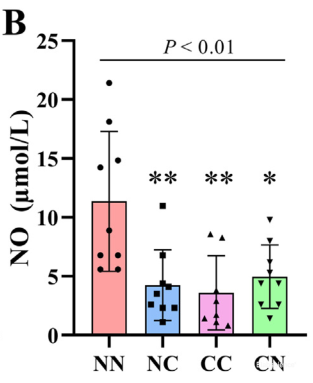Nitric Oxide (NO) Colorimetric Assay Kit
To better serve you, we would like to discuss your specific requirement, Please Contact Us for a quote.
Nitric Oxide (NO) Colorimetric Assay Kit
| SKU # | E-BC-K035-S |
| Detection Instrument | Spectrophotometer (550 nm) |
| Detection Method | Colorimetric method |
Product Details
Properties
| Synonyms | NO |
| Sample Type | Serum, plasma, tissue |
| Sensitivity | 0.97 μmol/L |
| Detection Range | 0.97-700 μmol/L |
| Detection Method | Colorimetric method |
| Assay type | Quantitative |
| Assay time | 80 min |
| Precision | Average inter-assay CV: 5.200% | Average intra-assay CV: 3.400% |
| Other instruments required | Vortex mixer, Centrifuge, Analytical Balance, Micropipettor |
| Other reagents required | Normal saline (0.9% NaCl), PBS (0.01 M, pH 7.4) |
| Storage | Reagent 6: -20℃, others: 2-8℃ |
| Valid period | 12 months |
Images
BYWng et al investigate the mechanism between cold exposure, gut microbiota and hypertension. Nitric oxide (NO) level of rat plasma was determined using NO colorimetric assay kit (E-BC-K035-S).

NO level was significantly reduced by cold exposure. (P<0.01)
Dilution of Sample
It is recommended to take 2~3 samples with expected large difference to do pre-experiment before formal experiment and dilute the sample according to the result of the pre-experiment and the detection range (0.97-700 μmol/L).
The recommended dilution factor for different samples is as follows (for reference only):
| Sample type | Dilution factor |
| Human serum | 1 |
| Human plasma | 1 |
| 10% Mouse liver tissue homogenization | 1 |
| Rat serum | 1 |
| Mouse serum | 1 |
| 10% Epipremnum aureum tissue homogenization | 1 |
Note: The diluent is double distilled water, normal saline (0.9% NaCl) or PBS (0.01 M, pH 7.4).
Detection Principle
NO is easily oxidized to form NO2- in vivo or in aqueous solution, and a reddish azo compound is formed with the color developing agent, and the concentration of the azo compound is linearly related to the concentration of NO. The concentration of NO can be calculated indirectly by measuring the OD value at 550 nm.

Kit Components & Storage
| Item | Component | Size 1 (50 assays) | Size 2 (100 assays) | Storage |
| Reagent 1 | Sulphate Solution | 50 mL × 2 vials | 50 mL × 4 vials | 2-8℃, 12 months |
| Reagent 2 | Alkali Reagent | 50 mL × 1 vial | 50 mL × 2 vials | 2-8℃, 12 months |
| Reagent 3 | Chromogenic Agent A |
19 mL ×1 vial | 38 mL ×1 vial | 2-8℃, 12 months shading light |
| Reagent 4 | Chromogenic Agent B |
Powder × 1 vial | Powder × 1 vial | 2-8℃, 12 months shading light |
| Reagent 5 | Acid Solution | 12.5 mL × 1 vial | 25 mL × 1 vial | 2-8℃, 12 months |
| Reagent 6 | Sodium Nitrite Standard |
Powder × 1 vial | Powder × 2 vials | 2-8℃, 12 months |
Note: The reagents must be stored strictly according to the preservation conditions in the above table. The reagents in different kits cannot be mixed with each other. For a small volume of reagents, please centrifuge before use, so as not to obtain sufficient amount of reagents.
Technical Data:
Parameter:
Intra-assay Precision
Three human serum samples were assayed in replicates of 20 to determine precision within an assay (CV = Coefficient of Variation).
| Parameters | Sample 1 | Sample 2 | Sample 3 |
| Mean (μmol/L) | 18.50 | 264.00 | 457.00 |
| %CV | 3.8 | 3.2 | 3.2 |
Inter-assay Precision
Three human serum samples were assayed 20 times in duplicate by three operators to determine precision between assays.
| Parameters | Sample 1 | Sample 2 | Sample 3 |
| Mean (μmol/L) | 18.50 | 264.00 | 457.00 |
| %CV | 5.0 | 4.9 | 5.7 |
Recovery
Take three samples of high concentration, middle concentration and low concentration to test the samples of each concentration for 6 times parallelly to get the average recovery rate of 99%.
| Sample 1 | Sample 2 | Sample 3 | |
| Expected Conc. (μmol/L) | 164 | 395 | 522 |
| Observed Conc. (μmol/L) | 162.4 | 395.0 | 511.6 |
| Recovery rate (%) | 99 | 100 | 98 |
Sensitivity
The analytical sensitivity of the assay is 0.97 μmol/L NO. This was determined by adding two standard deviations to the mean O.D. obtained when the zero standard was assayed 20 times, and calculating the corresponding concentration.



